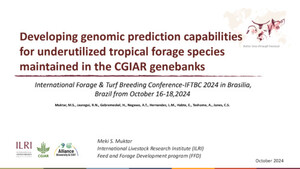
High-cut harvesting of maize stover and genotype choice can provide improved feed for ruminants and stubble for conservation agriculture
Abstract
In smallholder crop–livestock systems where maize (Zea mays L.) is a staple cereal, the stover is usually an important but low‐quality ruminant feed. Maize stover has various competing uses, and optimal allocation of stover, particularly for forage and mulch, is essential for improving whole‐farm productivity and sustainability. Knowledge that feed quality increases with height in maize stover provides opportunities. An experiment investigated the effects of a high cutting height of stover at grain harvest (cut at two internodes below the lowest ear) on the yields and feed quality of the upper and lower stover (stubble) fractions. Measurements were made on six maize genotypes at two sites during two cropping seasons in Ethiopia. The upper stover fraction (USF) on average comprised 674 g kg–1 of the entire stover and was also substantially higher (P < .001) than the lower stover fraction (LSF) in in vitro dry matter digestibility (527 vs. 450 g kg−1 dry matter [DM]) and total N concentrations (8.8 vs. 6.2 g kg−1 DM) and was lower in fiber. Stems (including leaf sheath and tassel), husks (including shank), and leaf blade comprised 484, 310, and 206 g kg−1 of the USF, respectively. Yields and feed quality of stover varied among genotypes and environments. Use of an USF can provide a feedstuff of increased nutritional quality for ruminants, but the efficacy of the LSF for mulch requires investigation. In conclusion, a simple management change to harvest maize stover at higher stubble height combined with use of appropriate genotypes can provide higher‐quality feed while leaving stubble for conservation agriculture.
Citation
Dejene, M., Dixon, R.M., Walsh, K.B., McNeill, D., Seyoum, S. and Duncan, A.J. 2022. High-cut harvesting of maize stover and genotype choice can provide improved feed for ruminants and stubble for conservation agriculture. Agronomy Journal 114(1):187–200.









